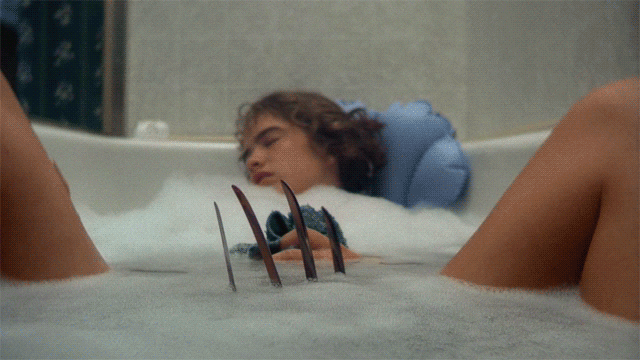
Though my previous in-depth takes on movies such as Little Monsters, Beethoven, and Baby’s Day Out have provoked responses ranging from “imaginative,” to “a bit of a stretch,” to “outright pants-shitting lunacy,” there is not a movie buff worth their salt who disagrees that A Nightmare on Elm Street Part 2: Freddy’s Revenge is the gayest horror movie of the 80s, and therefore of all time. The homoerotic subtext and the effect the film’s initial critical response had on the life and career of then-closeted star Mark Patton have been the subject of numerous articles, as well as the recent documentary Scream, Queen! My Nightmare on Elm Street. Screenwriter David Chaskin infamously claimed it was all unintentional on his part and entirely a result of Patton’s performance, then admitted the subtext was intended in the documentary Never Sleep Again: The Elm Street Legacy.
Freddy’s Revenge opens with the first of several dream sequences experienced by the protagonist, Jesse Walsh (Patton), in which he sits alone at the back of a school bus, a sallow outcast ignored by his peers. The bus gradually empties of all other male students, leaving only Jesse and two girls, who appear to be talking about him and giggling. This image of Jesse as the greasy-haired, jaundiced loner is far from the healthy, relatively well-adjusted youth we see in later scenes, in the frame of reality. This is how he sees himself, or at least his hidden self, the side that would cause him to become a pariah if it were known; it is a subconscious manifestation of his homosexual desires.
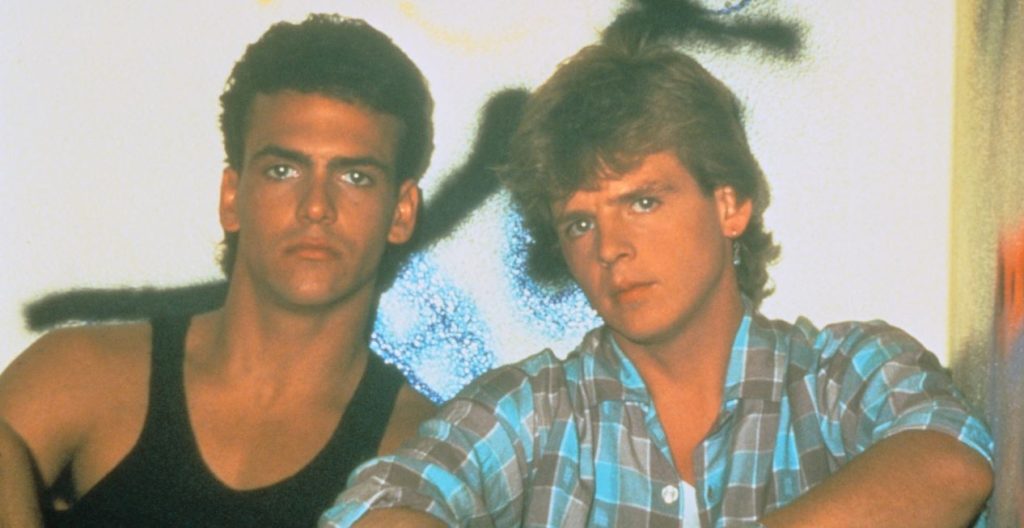
The danger of being exposed comes to life in the form of Freddy Krueger (Robert Englund), who plays the role of the bus driver in this first dream, driving Jesse and the two girls into a nightmarish hellscape where the earth crumbles around them until they are atop a giant stone pillar. Freddy then menaces the trio until they are backed into the far corner of the bus, making it (Jesse’s subconscious manifestation of his facade of normalcy) teeter over the brink of the abyss.
“Why can’t Jesse wake up like everybody else?” his little sister, Angela (Christie Clark), asks their parents after Jesse can be heard shrieking himself awake from this nightmare. Because he’s a scream queen, little lady! The very first male scream queen, and a top-notch one. Patton’s performance throughout is very strong, full of convincing terror, hysteria, and anguish, and his pipes for the screams themselves are on par with the best in the genre. At the breakfast table, Angela shows him her press-on nails and Jesse looks disturbed, presumably because they are reminiscent of Freddy’s “claws” and the secret, longed-for fabulousness they represent.
Jesse’s relationship with Lisa Webber (Kim Myers) is a major conflict in the movie, as she seems to want more than a platonic friend, while Jesse is what could be generously described as not ready. “He’s my ride to school,” Lisa tells a friend, not in a way that suggests she might be using Jesse, but in a dejected tone that suggests she wishes for more. Jesse is briefly distracted during a baseball game by this conversation, but it reads more as concern that the girls are talking about him (shades of his fear of persecution) than attraction to Lisa, and it is only a minute or so later that he’s in a bare-assed squabble in the dirt with his true love interest, Ron Grady (Robert Rusler). The sadistic Coach Schneider (Marshall Bell) completes the homoerotic love triangle Lisa can only watch from afar, as he pulls the two randy boys out of the dust and tells them to “assume the position.”
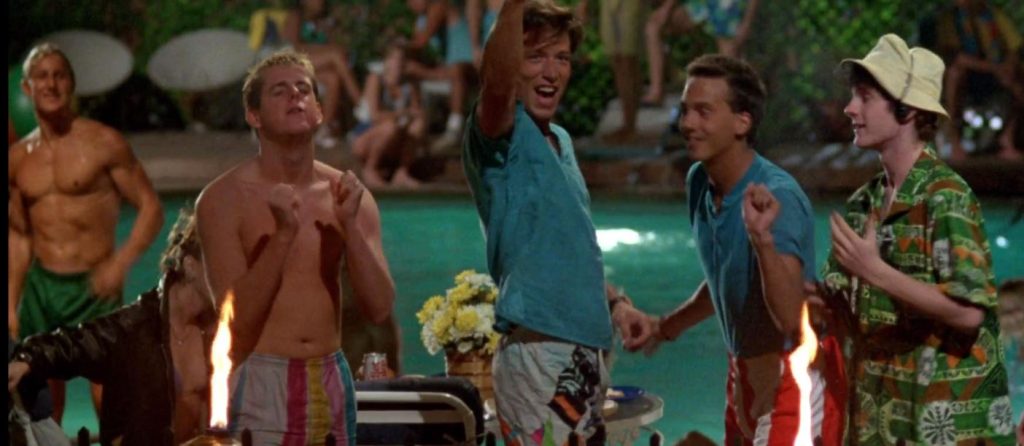
Coach Schneider’s reputation at the school is one of a few instances in which the homoerotic subtext of the movie transforms into actual text, as Grady tells Jesse that Schneider “gets his rocks off” by punishing teen boys such as themselves. “Hangs around queer S&M joints downtown,” he continues. “He likes pretty boys like you.” Grady then immediately segues into the question of whether Jesse is “mounting” Lisa, so questions about Jesse’s sexuality are clearly intentional enough to transcend mere subtext. Grady is also the one who tells Jesse about what happened in his new home (the house previously occupied by Nancy and her family in the first film), so he is partly responsible for awakening Jesse’s awareness of “Freddy” (his repressed homosexual urges and the threat they represent to his social standing, etc) inside himself.
In the second dream sequence, Jesse sees Freddy in the basement of the house, tending the boiler, but then he emerges from this subterranean level and takes hold of Jesse, shushing and caressing him with the razor-claws like a lover. “Freddy” can no longer be contained in Jesse’s “basement,” his innermost thoughts and desires. Shortly after, there is a hint of a third dream sequence, as Jesse falls asleep in biology class and a snake (which could almost be seen as symbolic of something) cuddles up to him and licks his sleeping face. It turns out to be a prank, though, perpetrated by none other than Jesse’s rival/unrequited lover Grady.
And then there is the infamous scene in which Jesse unpacks his new room and manages to turn the whole process into a fabulous dress-up/dance party complete with feigned masturbation. His mother (Hope Lange) walks in on this display of gay stripper rehearsal with Lisa and chuckles. “I’ll leave you two alone,” she says, because what she has just seen tells her there will be no hanky, nor any panky, with Lisa or any other girl in that particular room.
In fact, there is a sign reading NO CHICKS on Jesse’s bedroom door, and a game called PROBE in his closet, so clearly the production design team knew what was really going on. More significantly, the closet is also where Lisa finds Nancy’s diary, which leads her and Jesse to more information about “Freddy.” So Jesse’s secret identity is literally uncovered from the closet by the girl who wants to fuck him. Jesse then playfully reads aloud what at first seems like a sexy dream about a man, and his face and tone change as he realizes he’s been having the same dream.
The threat posed to Jesse’s family by his secret manifests as the house always being too hot, due to “Freddy” down there in the basement, continually stoking the fires of the boiler. This leads to the bizarre spontaneous avian combustion scene that serves to create a rift between Jesse and his dad (Clu Gulager), who accuses him of “setting the whole thing up” and drives him out to the streets.
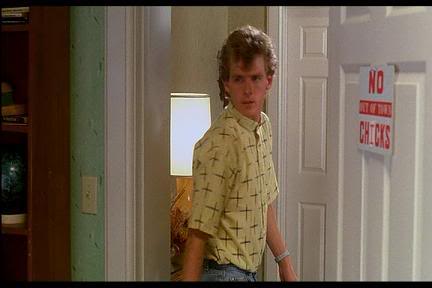
This and their later confrontation over the history of the house can be seen as symbolic of an unpleasant and poorly received coming out, and the reaction of Jesse’s dad leads him to seek solace at Don’s Place, a not very convincing stand-in for the “queer S&M joints” Grady mentioned earlier. Of course, the inexperienced Jesse has no actual firsthand knowledge of such places, so the objective reality of the sequence in which he encounters Coach Schneider at the bar is in question; perhaps this average dive bar with a bartender and a few patrons in leather is just how Jesse’s dreaming mind envisions a gay bar. Certainly at least some of it is Jesse’s dream, regardless of how dead Schneider ends up in reality.
There is undoubtedly a dream logic to the way Coach Schneider finds Jesse at the bar and punishes him by taking him back to the gym to run laps. And is the punishment for being underage at the bar, or for discovering Schneider’s own hidden secret side? Schneider is Jesse/Freddy’s first murder, and it is a notoriously homoerotic scene, with Schneider being bound and lashed by the same jump ropes and wet towels he has presumably used on Jesse and many other boys. This, then, is the Freddy’s revenge of the title, but it is really Jesse’s, and the sexually charged nature of the whole surreal encounter suggests it is vengeance not just for the petty harassment and bullying Coach Schneider has actually done, but for the conflicted, tortuous longing it has aroused in Jesse.
Grady is the polar opposite of Jesse, a cartoon of heteronormative masculinity, talking through a stuffed mouth with his three cartons of milk in the school cafeteria. “I wish you would talk to me,” Lisa laments to Jesse in this scene, distraught that he will never feel the way she does. “We can figure it out together.” “There is nothing to figure out,” Jesse tersely replies; she will never be his girlfriend. He and Grady then have a minor confrontation that hints at the murder to come, caused by both Jesse’s desire to be with Grady in a way he can’t make himself feel for Lisa, and his desire to be Grady, a normal straight male without the curse of homosinuality rising up inside him.
Jesse does make the effort to “become straight” with Lisa at her pool party, and this soon leads to all manner of hell breaking loose as “Freddy” violently revolts against this betrayal of Jesse’s true self. Jesse’s tongue becomes monstrously elongated and vile as he begins to go down on Lisa. Horrified at this reverse impotence, he abruptly leaves her in the cabana and runs to Grady’s house, where he sneaks into the bedroom and looks deeply into Grady’s eyes with one hand over his mouth. He then begs Grady to let him spend the night, and proceeds to explain the “monster” that’s growing inside him. “Something is trying to get inside my body,” he cries. “Yeah,” Grady replies, “and she’s female, and she’s waiting for you in the cabana, and you want to sleep with me.” Another instance of subtext becoming text.
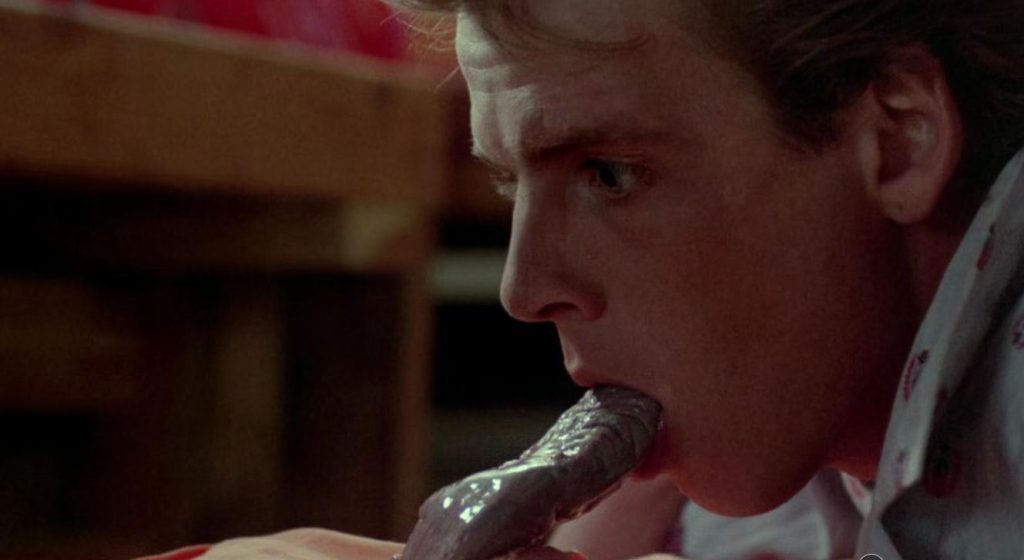
When Freddy comes out of Jesse’s body to kill Grady, literally bursting through his skin into waking reality, the movie achieves its full potential as a Cronenbergian psychological horror film in which Freddy himself is barely a character (only 13 minutes of screentime, his briefest appearance) and much more of a gruesome symbolic device. His secret identity finally in full control, Jesse penetrates Grady so hard the claws go through him and the bedroom door, in the movie’s wettest, messiest kill so far.
Grady’s murder seems to be the catalyst for Freddy to return at full power, having annihilated the two main authors of his conflicted existence, and he unleashes remote, apparently psychokinetic destruction on the pool party while simultaneously terrorizing Lisa. The massacre of the pool party can easily be seen as the lashing out of the outcast against his peers; as previously stated, this outcast role is how he sees himself, especially now that there is no longer any outer facade of normality to hide behind.
Lisa’s crime, presumably, is knowing the truth about Jesse and his inability to be aroused by her. She tries in vain to kill Freddy, sobbing in anguish at the Jesse she thought she knew being reduced to his hidden inner self. The facade of heteronormativity is what she wants and loves, not Jesse’s true self with its hideous desires. It is ultimately this “love” on Lisa’s part that destroys “Freddy,” but at what cost? “He’ll die with me,” Freddy warns her as her repeated proclamations of love for the “real” Jesse cause Freddy to crumble and die, indicating that Jesse destroying this essential part of himself out of “love” for Lisa will slowly kill him inside.
Jesse cracks through the burnt facade of Freddy’s flesh and is born-again straight, ready to embrace a life with Lisa that will never be anything more than an empty shell as he commits to hiding his true self, perhaps “until death do they part.” Their embrace in this climactic scene is far from a passionate lovers’ one, as Jesse sinks resignedly into Lisa’s arms and she holds him, sobbing with apparent happiness at this pyrrhic victory, in which she gets to have her gay boyfriend and eat him too. Or perhaps it is mournful sobbing, as she knows, deep down, that she has signed on for a lifetime of wondering if he is cheating on her, and with who, and how many….
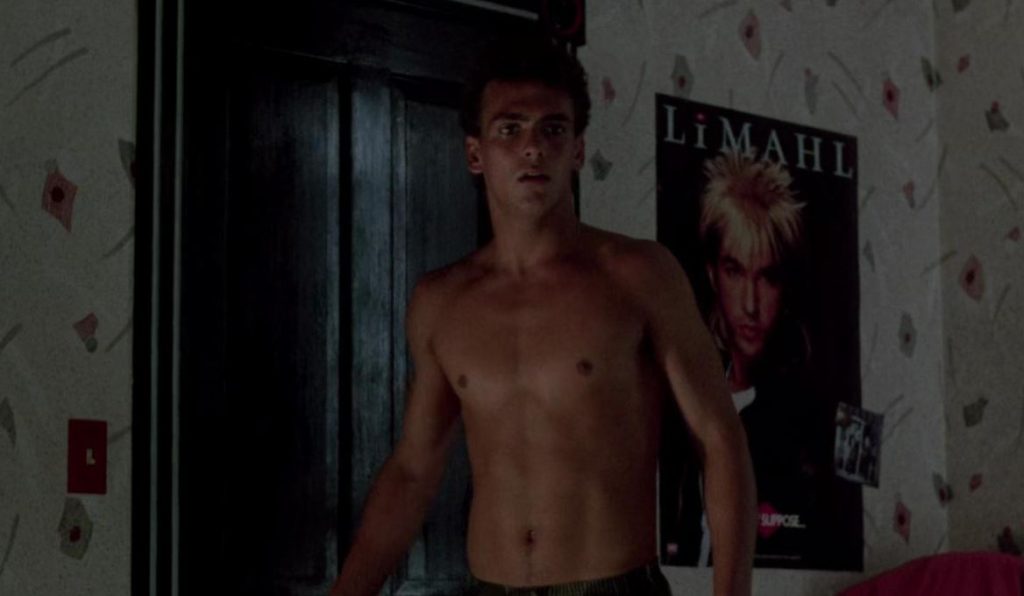
The final scene underlines the unhappy ending in a sort of repetition of Jesse’s opening dream sequence. “I can’t believe it’s actually all over,” a much healthier and happier-looking Jesse says to Lisa as they ride the school bus together. “Let’s not talk about it,” she replies, and Jesse meekly acquiesces, but then the bus begins to speed up, echoing that first dream and the awakening of “Freddy,” who then bursts quite literally through the “it’s all over” facade. Of course it appears to be just the prerequisite THE END? jump-scare, standard with any slasher (especially a sequel), but it hints that the nightmare will never be over for Jesse, as he spends the rest of his life trying to suppress the fabulous long-nailed monster inside himself.
Released in 1985, at the height of the AIDS epidemic, in the midst of Ronald Reagan’s America and the heightened homophobia of that turbulent time (which gradually became the more casual but still rampant homophobia of the 1990s, when I first saw and became fascinated by this movie), A Nightmare on Elm Street Part 2: Freddy’s Revenge is a brilliant work of pop art that was both of and ahead of its time. Its well-deserved cult following testifies to the fact that its obvious gayness was always a feature and not a bug.
Leave a Reply